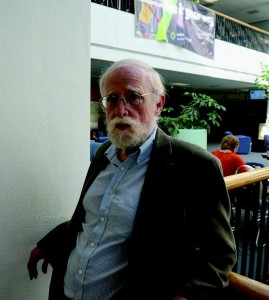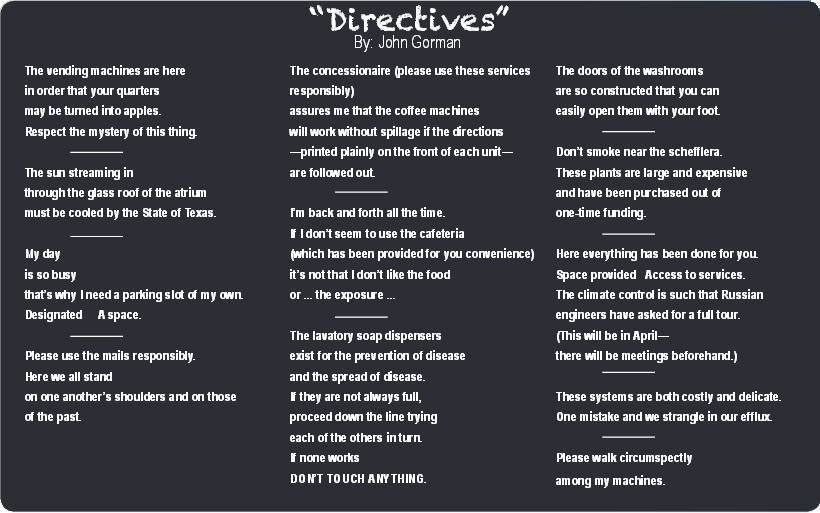Professors recall campus’ 40-year history

KRIS STIVERS
THE SIGNAL
The university is expanding to include freshmen and sophomore students with its four-year initiative, but in order to understand where the university is going, it’s important to know where it’s been.
Founded in 1974, the University of Houston-Clear Lake has undergone many changes during the last 40 years.
“We were founded to be interdisciplinary,” said John Gorman, professor of literature. “We wanted to let ideas and techniques from the more restrictive traditional majors flow back and forth and enrich the academic and personal lives of all involved.”
Gorman recounted the first year when there were just slightly more than 1,000 students enrolled and there was no organized student life.
“Everything had to be invented from scratch, which was interesting,” Gorman said. “It was all very homemade. The spirit was good. The spirit of pioneering inventiveness is always fun, because people’s spirits are always high.”
A year later Nick de Vries, professor of fine arts, joined the UHCL faculty and, along with fellow fine arts professor Sandria Hu, cofounded the university’s art program. It was a very different art program from the one students know today.
“In 1975 our first classes in studio art were offered,” de Vries said. “Two of us were hired to teach courses in traditional two- and three-dimensional art. I taught all courses in 3-D work (ceramics and sculpture) and Professor Hu taught all courses in 2-D work (drawing, painting and printmaking).”
The art department has since expanded from three full-time faculty members to eight full-time and eight adjunct faculty members, and it wasn’t just the faculty that increased.
“[Initially] all of our classes were in the Arbor Building, where we used the atrium as an art display area,” de Vries said. “From all classes meeting in the same large studio, we slowly took over other spaces as our enrollment increased. Today we have one of the finest facilities in the country.”
While many academic programs started small and flourished, some have come and gone over time.
“We used to have theatre and dance,” Gorman said. “They were cancelled for financial reasons — some would say ‘alleged’ financial reasons. It was a big loss. We’ve also discontinued a program in future studies in which imaginative and valuable things were done.”
Throughout the years, there have been numerous events with notable speakers including Danny Glover, Barbara Bush, Olympia Dukakis and Dana Carvey. Gorman recalled the first guest speaker to visit the university.
“One of the business professors had known a man who was in the movies, Buster Crabbe, who, if I’m remembering right had [played] ‘Tarzan’ at one point,” Gorman said. “He was brought in to speak on campus, and that was our first outside speaker.”
The university’s first literary event also took place that year, following the death of famed poet Anne Sexton.
“[Former Professor of Literature] Gretchen Mieszkowski, [Former Professor of Psychology] Nanette Bruckner, and I organized a memorial reading for her in the Arbor building, which is where all the classes were held at the time,” Gorman said. “That went well. Anne Sexton [was] a terrific poet. Just to spice things up I read one of her poems called ‘In Praise of My Uterus.’”
With the underclassmen joining the university this fall, it will be interesting to see what popular trends catch on amongst the student body. Neither Gorman nor de Vries could recall any trends that stood out over the years.
“Our students, from the very start, had an average age in their 30s,” Gorman said. “Older people are less given to trends — no disco then, no twerking now. But many of those who planned the university were surprised by the strong interest in feminism, also there from the start. I think if a residential culture develops here, you’ll begin seeing more things like that. You need a self-defining undergraduate life to develop traditions.”
De Vries added that although trends had not been noticeably different over the years, one thing did have a major impact on the university — technology.
“The computer had a significant impact on the way students were learning,” de Vries said. “It had particularly impacted the areas of Web and graphic design.”
Gorman believes that the four-year initiative could be an opportunity to bring the university’s founding principles to fruition.
“The thing that held interdisciplinary formats at bay was not having freshmen and sophomores,” Gorman said. All along we’ve recruited professors with the interests we had pursued ourselves—so maybe the interdisciplinary idea will flourish again in the four-year UHCL.”
When asked what they would say to their past selves if the opportunity presented itself, Gorman and de Vries shared similar sentiments.
“I would tell him that I’m sure glad he changed his occupation to becoming an art educator,” de Vries said. “UHCL has been a great place to work, if you want to call it work. I have loved coming to work everyday and working with and for some of the best people I have ever known. I have always received great support.”
Gorman noted that he and his past self are still very close.
“Actually my former self and I are still in touch,” Gorman said. “UHCL turned out to be an excellent place to foster the values I brought to it in 1974. The responsiveness and accomplishments of the students have been a delight.”



I graduated from UHCL in 1979, BA Humanities. Thanks to Nick DeVries and Dr. Bruckner, I learned to challenge myself and expect the extraordinary in my life. I didn’t pursue art, but the critical thinking skills I obtained, along with a lifelong love of the arts and all cultures, allowed for a successful career as an LPC in Texas.
Thanks! Diane Broady Wilson